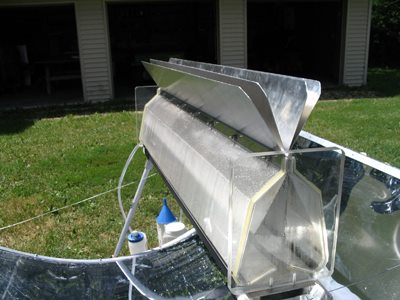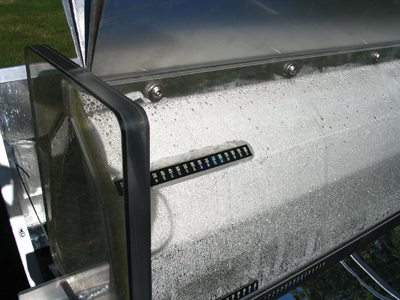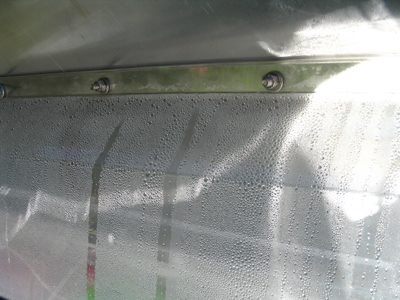A few years ago a storm flooded the local water treatment facility leaving me and all my neighbors without water for several weeks. Partially motivated by this I designed a portable solar powered water distiller. The idea is that a person adds water from any source (assumed to be dirty, salty or otherwise unfit for drinking) in one side and over the course of the day gets clean safe drinking water out the other side.

At the heart of this design is an innovative method for forming a medium size parabolic mirror using a flexible aluminized mylar sheet (the shiny metallic foil commonly used to make potato chip bags/decorative balloons). I built an aluminum frame, using 1 inch wide by 1/8 inch thick strips, that runs around the edge of the mirror and use a pair of wires at either end to draw the frame up into a parabola. The mirror is actually sandwiched between an upper frame and a lower frame. This mylar sheet, frame and wire construction makes a good parabola, is inexpensive, lightweight, and can be easily assembled/disassembled.
The aluminum frame is much stronger than necessary (& more expensive) and could easily be made out of a cheap local material like wood or plastic. The function of the frame is to 1) hold/capture the mylar sheet, and 2) provide some stiffness so the wire stays taught. The wire length determines how steep or shallow the parabola is, which in turn determines how close/far the focus of the mirror is from the mirror surface. The mirror is cheap (a few dollars) and ideally the frame should only cost a few more, altogether I’d guess it should cost under $10 to make the mirrors in any serious volume (maybe $10-$15 in moderate volume). I say should, because I’m still working with a prototype, and a custom job costs at least 10 times what I think the cost should be… Still I imagine a big cheap mirror can be useful in any number of solar applications besides water purification.
The mirror is placed under an evaporation chamber where the water is purified. The evaporation chamber has an aluminum pan (painted black to absorb the sunlight/heat) into which I add a trickle of ‘dirty’ water which is heated until it evaporates. This pan has a clear plastic cover which captures and condenses the water vapor as well as an interior lip that channels this pure/condensed water out of the distiller. The two piece evaporation chamber can be taken apart for cleaning or storage. At the moment the parabolic mirror needs to be adjusted by hand each hour to keep the sunlight focused on the pan, although this ‘tracking’ could be automated fairly simply by adding a small motor.
In the interest of keeping the device portable, I’ve only used a 2 square meter mirror which distills ~ 1 gallon of water/day. I’m working to boost the treated volume by a factor of two with additional design improvements—in theory a mirror this size could distill 4 gallons/day. I could also increase the distilled water production volume by using a larger mirror, doubling the mirror would double the production, although it would be that much harder to transport. The device weighs about 40 lbs, and the mirror can be rolled up like a poster.
In fact my big problem at this time is that I’m collecting too much sunlight/heat onto the pan and the plastic cover gets so hot (60-70 degrees C) that the water vapor doesn’t condense as well as it should. The little metal fins at the top of the distiller are designed to help remove heat from the condensing cover. For scale, the mirror is 6 ft. x 4 ft. and the evaporation chamber is roughly 3 feet off the ground.
This is a fairly simple device. I’ve spent a few years working and improving the design almost entirely on my own. Last year I filed for a US patent on it, so the design is officially patent pending. I’d be delighted if some person or group found a situation in a developing/island country where this distiller would be useful (and I’d be happy to help in any way I can—adapting the design for local construction with local materials etc.), but I don’t want some major US corporation copying the idea, filing for a patent and potentially preventing me from using my invention!
Other useful resources:
Blackout USA (EMP survival and preparedness)
Conquering the coming collapse (Financial advice and preparedness )
Liberty Generator (Easy DIY to build your own off-grid energy source)
Backyard Liberty (Easy and cheap DIY Aquaponic system to grow your organic and living food bank)
Source: thesietch.org




If you were to black out the condenser area, and use insulated material to help keep it cooler that would probably help.
Additionally the heat sinks are going to be absorbing too much energy from the sun, and transmitting the energy into the condenser. Using some copper pipe to move the heat to somewhere else like your water input area might be a good idea, and it would help preheat the water to be distilled.
Nice Post ! Thank you for sharing!